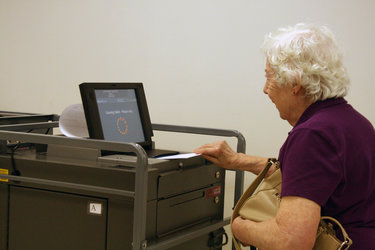New election laws: Options abound, as does criticism
ALBANY COUNTY — Governor Andrew Cuomo in August signed into law a series of what he termed “sweeping election reforms that will make it easier for New Yorkers to vote and be counted in November.”
The new laws give voters the right to request an absentee ballot due to risk of illness — either to the voter himself or others; made ballots available seven weeks earlier than otherwise: 30 days before Election Day; and allow for ballots to be mailed in right up until Nov. 3.
On the governor’s “sweeping election reforms,” Albany County Board of Elections Democratic Commissioner Matthew Clyne said that they are basically a continuation of protocols that were put in place during the primary.
Albany County has had 20,000 requests for ballots so far — and there’s still about six weeks to go until the general election, Clyne said; 20,000 is the same number of ballots that were requested in the June Democratic primary. During a pre-COVID presidential election, the board of elections would normally receive about 10,000 requests for ballots, and about half that number in off-year elections.
Over eight in 10 Americans are eligible to vote by mail in November’s election, which is the most ever — while one in three voters plans to actually vote by mail. Mail-in voting requires more steps than in-person voting, which is likely likely to lead to more errors — which leads to more rejected ballots.
In separate analyses of rejected ballots in this year’s presidential primaries, both The Washington Post and National Public Radio found that more than 84,000 ballots were tossed in New York State, all were in New York City — it was the second highest number of rejected ballots among the states analyzed by the media outlets; California was first with more than 102,000 rejected ballots.
Last week, New York State reached a settlement with the League of Women Voters of New York State over a case the organization brought on behalf of a woman with a neurological condition that causes hands to tremor. When her hands would shake, it would render her signature unrecognizable, putting her ballot at risk of rejection due to a mismatched signature.
“[The] terms of the settlement specify how voters will be contacted if their ballot is rejected and how they can fix the problem. The state has expanded who will benefit from this ‘cure’ process to include other types of errors beyond their signature, including defects with their envelope,” according to the League of Women Voters. “It will also, for the first time, provide a clear list of technical issues — such as use of pencil or extraneous marks on the ballot — that do not trigger ballot rejection and do not require any further voter action. Counties had previously used many of these reasons to disqualify ballots, leading to alarming ballot rejection rates, including in this year’s primary elections.”
When asked what the provisions of the lawsuit will mean for the Albany County Board of Elections, Clyne said, “It’s going to be a huge thing.”
But Clyne also said that the lawsuit was redundant because the governor signed similar cure provisions into law already, on Aug. 21.
The new language signed into law says in part: “Upon the board of elections determination at or before the time of canvass that an absentee ballot affirmation envelope is unsigned or that an affirmation ballot envelope signature does not correspond to the registration signature or there is no required witness to a mark or that the envelope is returned without an affirmation envelope in the return envelope, the board shall, within one day of such determination, send to the absentee voter’s address indicated in the registration records and, if different, the mailing address indicated on the absentee ballot application, a notice explaining the reason for such rejection and the procedure to cure the rejection.”
Clyne went on to say that the “cure” provisions brought on by the lawsuit can be eliminated, the bill in the legislature was not necessary, and that there isn’t a need to encumber county boards of elections because: “All you really have to do is read the instructions on the absentee ballot envelope, that’s all you have to do.”
As for the politics of vote-by-mail, Edie Goldenberg, a professor of public policy and political science at the University of Michigan, writes at The Conversation, a not-for-profit site that publishes academics and researchers, “Some critics — including President Donald Trump on several occasions — have cast doubt on the integrity of mail-in voting … [But] the evidence we reviewed finds that voting by mail is rarely subject to fraud, does not give an advantage to one political party over another and can in fact inspire public confidence in the voting process, if done properly.”
Asked how to avoid in the general election the delay counting votes during the primary election, Clyne said, with the protracted Albany County District Attorney Democratic primary in June, candidate Matt Toporowski, who ultimately lost to incumbent David Soares, requested a hand-count of the mail-in ballots and, “depending on the number of ballots, if it’s a contested election, you just have to sit through that.”
Clyne added that the board of elections didn’t open its mail-in ballots until a week after the primary election. So, if there hadn’t been a ballot-by-ballot review, he said, then all the ballots would have been placed in the central-count tabulator, a process that would have taken “a couple of days,” he said.
New laws
The new laws were not thought through before they were enacted, Clyne said; no one thought about the new laws’ logistics or the operational impact. And no one fully appreciates the ramifications of implementing the new voting laws, he said, because they could alter the timeline for determining the winner of an election — altering the nature of the post-election canvass, as Clyne put it.
“It’s easy to say, ‘OK, everybody gets an absentee ballot or everybody should get an absentee ballot.’ But the reality is, we’re not a vote-by-mail state and everybody has to shift gears now at the drop of a hat to accommodate a process that is not easily implemented,” he said.
Asked what he meant by the new state laws could alter the nature of the post-election canvass, Clyne explained that it could alter the ability to obtain a result in a close contest: There could be a protracted post-election canvass and, depending on the level of scrutiny and the intensity of the review process, it could take weeks or even months.
Clyne pointed to the race for the Ulster County District Attorney as an example.
That race, he said, “went on and on.”
In that 2019 election, after a narrow election and requested ballot recount, Republican Mike Kavanagh conceded defeat to Democrat Dave Clegg two months after the November election.
“If you magnify that for a general election, where you’re having huge numbers of paper ballots come in — it’s just a big challenge, logistically to sort this stuff,” Clyne said. “Candidates have the right to review the ballots and, if they do that, it can be very labor intensive and very time consuming.”
So there are a lot of issues that have been created by the new law — to say nothing of the sheer mechanics of it all.
If 2,500 ballots were being stuffed into envelopes and sent out, it’s not a big deal; 25,000 of them is a big deal, Clyne said.
In a response to a request for comment to Clyne’s criticisms of the state’s new voting laws, The Enterprise received the following statement from the governor’s spokesman Richard Azzopardi: “Clyne has spent his entire adult life being Conan the Contrarian and always on the wrong side of history.
“Years ago he opposed our online voter registration system through the DMV [Department of Motor Vehicles], which has been an unquestionable success and just this year he refused to wear a mask during the primary absentee count. Am I surprised that he isn’t supporting voting reforms designed to keep people safe from a deadly virus? Not really.”
When given the opportunity to respond, Clyne would say only Azzopardi’s statement did not address the merits of his criticism.
Another issue Clyne pointed out with the state’s new hybrid voting approach: All in-person polling sites have to be maintained on Election Day as if it were a normal election day in addition to having to process applications for as many as 40,000 or 50,000 mail-in ballots.
Clyne is estimating that the board of elections will ultimately receive between 40,000 and 50,000 ballots requests. “So it’s qualitatively different from what it would normally have been,” he said.
There are about 190,000 active voters in Albany County, he said, and about 207,000 active and inactive voters.
Every application that comes in for a ballot has to be inputted, Clyne said, “It doesn’t get thrown in a box or something and magically converted to a ballot.” The application has to be inputted into the county’s voter registration database, so that a ballot can be produced. “So, when you’re doing 40 or 50,000 of those, that’s fundamentally different than what you would normally do,” Clyne said.
Poll workers
There won’t be a COVID-related shortage of poll workers, which Clyne attributes to the jobs being heavily advertised by the state. Early on, there had been fears that, with so many of the usual poll workers being elderly, they wouldn’t want the job for fear of being exposed to COVID-19. But new workers have applied for the jobs and are being trained.
On Election Day, about 1,250 poll workers will be needed, Clyne said, four per election district — two Demoratic inspectors and two Republican inspectors. And, in some of the larger polling sites that house multiple election districts, there is a poll-site coordinator to facilitate the voting traffic.
And, while the board does do some training for poll workers remotely, it’s also doing hands-on training, “which is the preferred method,” Clyne said.
For a veteran poll worker, an online refresher is fine, Clyne said. “But if you’ve never done it before, you should be in a class where you’re actually working with the machines, so you understand how they work.”
How to apply for an absentee ballot
Voters must apply for a general-election absentee ballot no later than seven days — Tuesday, Oct. 27 — before the election. However, they may apply in-person up to the day before the election: Monday, Nov. 2.
Voters may apply for an absentee ballot:
— Online via the New York State Board of Elections absentee application website;
— By emailing a request to the local county board of elections;
— By faxing a request to the local county board of elections;
— By going in-person to the local county board of elections;
— By mailing a paper application to the local county board of elections;
— By sending a letter to the local county board of elections. The letter must contain the voter’s name and date of birth; the address where the voter is registered; the address where the ballot is to be sent; the reason for the ballot request; and the voter’s signature.
If a voter cannot pick up his or her ballot in-person or doesn’t have the ability to receive it by mail, then that person has the right to designate someone to pick up the ballot for them.
Voters may return their ballot by:
— Putting it in the mail with a postmark no later than Nov. 3; or
— Bringing it to the local county board of elections office no later than Nov. 3.
Early voting
In Albany County, early voting begins Saturday, Oct. 24, and runs until Sunday, Nov. 1.
Election day is Tuesday, Nov. 3, polls will be open from 6 a.m. to 9 p.m.
Early voting times are as follows:
— Saturday, Oct. 24, from 9 a.m. to 2 p.m.;
— Sunday, Oct. 25, from 9 a.m. to 2 p.m.;
— Monday, Oct. 26, from noon to 8 p.m.;
— Tuesday, Oct. 27, from 9 a.m. to 5 p.m.;
— Wednesday, Oct. 28, from noon to 8 p.m.;
— Thursday, Oct. 29, from 9 a.m. to 5 p.m.;
— Friday, Oct. 30, from 9 a.m. to 5 p.m.;
— Saturday, Oct. 31, from 9 a.m. to 2 p.m.; and
— Sunday, Nov. 1, from 9 a.m. to 2 p.m.
Albany County voters may vote early at any of the following polling places:
— Guilderland Fire Department, 2303 Western Ave., Guilderland;
— Berne Volunteer Fire Company, 30 Canaday Hill Road, Berne;
— Bethlehem Lutheran Church, 85 Elm Ave., Delmar;
— Pine Grove United Methodist Church, 1580 Central Ave., Albany;
— Boght Community Fire Department, 8 Preston Drive, Cohoes; or
— Albany County Board of Elections, 224 South Pearl St., Albany


